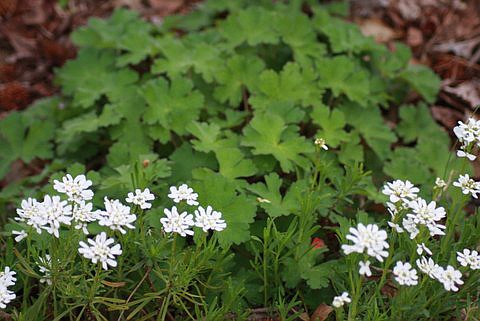Do you have a scruffy area under a tree where lawn grass just doesn't want to grow? Too much shade? Ground too dry? Tree roots make the ground uneven? Have you considered planting groundcovers to replace that grass? A bed with a groundcover under the trees can add a polished look to your yard.
Groundcovers need less maintenance than grass. You will not have to mow, fertilize overseed, aerate or water as you would a lawn. On the other hand, you will need to weed and water regularly until the groundcover is established. You may also need to water in dry weather. You will have to do fall and spring clean-up such as clipping off dried leaves and flower stalks or raking out leaves.
In establishing a healthy groundcover bed, your focus should be on making sure you put the right plant in the right place. Determine what kind of light and shade the area receives. Does the area have full shade? Dappled shade? Does it get morning sun? Late afternoon sun? Determine how dry or moist the ground is. Tree roots may keep the ground dry. If the area is on a slight incline or at the bottom of one, though, it may absorb moisture from run-off. Determine if the soil pH is acidic or alkaline. If the area is under conifers or oak trees, it is likely to be acidic. You can have the soil tested by your county extension service for a minimal cost.
Prepare for planting. Eliminate the weedy competition by pulling out the weeds and grass. If you are preparing your groundcover bed this winter, you can put down cardboard and pile it with leaves. By spring, you should have a layer of mulch, and the weeds underneath will be killed off. Then prepare the planting bed by raking in some compost and putting some compost in the planting holes. Because you are going to be planting under trees, your preparation should avoid disturbing the trees' roots, although it should be OK to dig through some surface roots when digging planting holes. You should avoid altering the soil level on top of the roots by more than a few centimeters as too much soil can smother surface roots.
Choose your plants. What kind of plant makes a good groundcover? Primarily, plants that spread underground to form colonies make good groundcovers. Other low-growing perennials or shrubs like azaleas can be planted as groundcovers, and while they may not create colonies, they will get larger and fill an area. If you choose shrubs, make sure to choose ones whose roots are not going to compete with the trees' roots, though. Keep in mind while some plants used as groundcovers will put on a show with flowers for a few weeks, you are primarily planting for interesting massed foliage.
So what plants are out there? Typical plants used as groundcovers include English ivy, lilyturf (also known as liriope or monkey grass) and pachysandra. But let's think outside the box. Take a look at native perennials, for instance. Wild ginger, sedges, geranium, and a low rosette with bright yellow blooms in spring known as squaw weed (senecio obovatus) are beautiful examples of native plants that can be used as groundcovers. Or try non-native perennials that spread, such as hostas, ostrich ferns, lamb's ears and coral bells (heuchera). These perennials, native and non-native, will attract a diverse group of pollinators and provide you with a more eye-pleasing display. How many plants will you need? It depends on how long you want to wait for them to spread. My colony of squaw weed has grown from three plants in 2009 to cover at least four by four foot area in 2016. On the other hand, the wild ginger plant I planted a couple of years ago has spread to cover an area about 15 inches in diameter.
In choosing your plants, you will have to weigh the various environmental factors in your yard. If you have conifers or oak trees, you will have "dry" shade under them. You may also have full shade since these trees usually don't let in much light. The soil will be acidic. Plants to consider for these conditions include sweet woodruff and oak sedge. Sweet woodruff is an herb with small white flowers and as the name indicates, a sweet scent underfoot. Oak sedge forms elegant clumps of grass-like leaves. It was chosen by Missouri Wildflowers Nursery as its 2011 "Plant of the Year." Deciduous trees have the ability to host a wide variety of groundcovers. Plants that prefer normal to moist soil in a shady woodland setting include sweet woodruff, squaw weed, many kinds of hostas, wild ginger, ferns, geranium, lily of the valley, epimedium and creeping Jenny. Lamb's ears, with their silvery, fuzzy leaves, prefer dryer soil and light shade.
I suggest familiarizing yourself with these plants by visiting garden centers, friends' gardens and Runge Conservation Area. Take a look at the Missouri Wildflowers Nursery catalog. The Central Missouri Master Gardener Plant Sale, held every spring at the Jaycee Fairgrounds, usually offers quite a few of the plants mentioned in this article. Master Gardeners are always on hand to answer your questions, as well.

